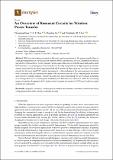| dc.contributor.author | Jiang, Chaoqiang | |
| dc.contributor.author | Chau, K. T. | |
| dc.contributor.author | Liu, Chunhua | |
| dc.contributor.author | Lee, Ho Tin | |
| dc.date.accessioned | 2018-12-07T18:42:57Z | |
| dc.date.available | 2018-12-07T18:42:57Z | |
| dc.date.issued | 2017-06 | |
| dc.date.submitted | 2017-06 | |
| dc.identifier.issn | 1996-1073 | |
| dc.identifier.uri | http://hdl.handle.net/1721.1/119479 | |
| dc.description.abstract | With ever-increasing concerns for the safety and convenience of the power supply, there is a fast growing interest in wireless power transfer (WPT) for industrial devices, consumer electronics, and electric vehicles (EVs). As the resonant circuit is one of the cores of both the near-field and far-field WPT systems, it is a pressing need for researchers to develop a high-efficiency high-frequency resonant circuit, especially for the mid-range near-field WPT system. In this paper, an overview of resonant circuits for the near-field WPT system is presented, with emphasis on the non-resonant converters with a resonant tank and resonant inverters with a resonant tank as well as compensation networks and selective resonant circuits. Moreover, some key issues including the zero-voltage switching, zero-voltage derivative switching and total harmonic distortion are addressed. With the increasing usage of wireless charging for EVs, bidirectional resonant inverters for WPT based vehicle-to-grid systems are elaborated. Keywords: magnetic resonance; wireless power transfer; non-resonant converters; resonant inverters; compensation networks; selective resonant circuits | en_US |
| dc.publisher | Multidisciplinary Digital Publishing Institute (MDPI) | en_US |
| dc.relation.isversionof | http://dx.doi.org/10.3390/en10070894 | en_US |
| dc.rights | Creative Commons Attribution | en_US |
| dc.rights.uri | http://creativecommons.org/licenses/by/4.0/ | en_US |
| dc.source | Multidisciplinary Digital Publishing Institute | en_US |
| dc.title | An Overview of Resonant Circuits for Wireless Power Transfer | en_US |
| dc.type | Article | en_US |
| dc.identifier.citation | Jiang, Chaoqiang et al. "An Overview of Resonant Circuits for Wireless Power Transfer." Energies 10, 7 (June 2017): 894 © 2017 The Authors | en_US |
| dc.contributor.department | Massachusetts Institute of Technology. Department of Electrical Engineering and Computer Science | en_US |
| dc.contributor.department | Massachusetts Institute of Technology. Research Laboratory of Electronics | en_US |
| dc.contributor.mitauthor | Lee, Ho Tin | |
| dc.relation.journal | Energies | en_US |
| dc.eprint.version | Final published version | en_US |
| dc.type.uri | http://purl.org/eprint/type/JournalArticle | en_US |
| eprint.status | http://purl.org/eprint/status/PeerReviewed | en_US |
| dc.date.updated | 2018-11-22T14:23:35Z | |
| dspace.orderedauthors | Jiang, Chaoqiang; Chau, K. T.; Liu, Chunhua; Lee, Christopher H. T. | en_US |
| dspace.embargo.terms | N | en_US |
| mit.license | PUBLISHER_CC | en_US |
